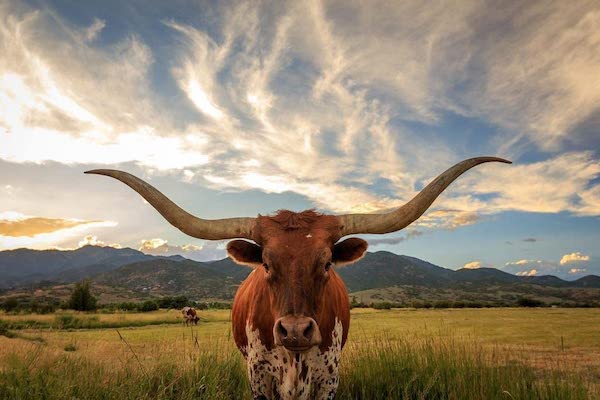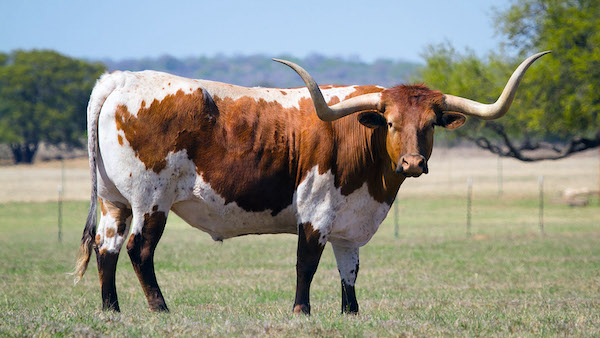Cattle production is considered one of the most important agricultural industries in the United States, accounting for over +$66 Billion in cash receipts and generally 15% to 20% of the billions in total cash receipts generated by all agricultural commodities. The U.S. is not only a top beef-eating country – number one in the world – we are also one of the world’s largest beef exporters.
There are over +1,000 different cattle breeds recognized worldwide, about 250 of which are beef cattle. About 60% of those beef breeds can be found in the U.S., too, although the industry is dominated by some clear favorites. Below are some of the most popular beef cattle breeds in the U.S. today
I always had to help my grandfather with his cow-calf operation. Through the years he had various operations where we would run mostly run Hereford or Simmental. He also liked to play around and buy and sell different bulls mostly Black Angus, Hereford’s or Charolais. It seemed like the absolute craziest and most difficult to keep in a fence were a couple of the Charolais we had. They were awesome-looking bulls but wow what a handful!
Angus: The Aberdeen Angus breed was first imported to Victoria, Kansas, from Scotland in 1873. Cattle in the U.S. at that time consisted of Shorthorns and Longhorns, so the typically polled, meaning hornless, Angus were quite unusual. Black Angus has since become the most dominant beef cattle breed in the U.S. To qualify as Certified Angus Beef, animals must meet ten strict requirements, including hide color, marbling, and rib-eye size. They are typically black in color, however, a new strain of cattle called the Red Angus emerged in the mid-20th century. In 1917, the American Angus Association barred the registering of red animals into the herd books in an effort to promote a solid black breed. In the 1940s, American cattle producers started breeding reds cropped from the best Angus herds and formed their own breed, which aside from color, has the same features and benefits as black Angus. Today, red Angus is the leading U.S. beef breed used in artificial insemination around the world.
Hereford: After the Texas Longhorn (and briefly the Durham), the Hereford, aka Herefordshire, became the dominant American beef breed. Originally imported from Herefordshire, England, in 1817 and spreading with settlers as they fenced off the American West, the Hereford became popular for its early maturity and efficiency. It’s also known for its adaptability to various climatic conditions and its hardiness. Hereford remained the dominant breed in the U.S. through the 1960s and remains influential in many crossbreeding programs. Certified Hereford Beef requires a face that is 51 percent white with absolutely no markings in white on the shoulders, side of the body, and hip.
Charolais: The Charolais breed is one of the oldest French cattle breeds, brought to the U.S. via Mexico in the mid-1930s. Charolais are generally white or creamy white in color. Charolais cattle can withstand cold temperatures relatively well and they are more heat tolerant than darker hided breeds. It is also among the heaviest of cattle breeds, with bulls weighing from 2,200 to 3,600 lbs. and cows from 1,500 to 2,600 lbs.
Gelbvieh: Gelbvieh (pronounced “g-el-vay” with a “silent” b) is one of the oldest German cattle breeds, first imported to the U.S. in 1971. They can be red or black and are usually polled, meaning they don’t have horns. They were originally what’s called a “dual purpose” breed, meaning they produced milk, meat, and work, though they are primarily bred for beef in the U.S.
Simmental: This Swiss breed is among the oldest and most widely distributed in the world. They have been raised in the U.S. since the late 1800s, but their popularity waned until the late 1960s. Most Simmentals are red and white, but there are no color restrictions on the breed. They are known for rapid growth development, milk production, and large size. Among all cattle breeds worldwide, this breed is second in numbers only to Brahman. Although primarily used as dairy cattle in Europe, American Simmentals are bred for beef production.
Piedmontese: The Piedmontese originated in the region of Piedmont, in north-west Italy. The calves are born fawn coloured, and turn grey-white as they mature. Piedmontese cattle carry a unique gene mutation identified as an inactive myostatin allele that causes hypertrophic muscle growth, or double muscling. A small group of select Piedmontese bulls and cows were imported into the United States in the early 1980s, and were used as the foundation breeding stock to develop a new breed of beef cattle known as North American Piedmontese cattle.
Limousin: Limousin The Limousin breed is native to the old provinces of Limousin and Marche in central France. French breeders placed a great deal of emphasis on a deep chest, strong topline, well-placed tailhead, and strongly muscled hindquarters. The result was an efficient, hardy, and adaptable animal well suited for meat production. Imported here since 1971, the Limousin breed (muscle and efficiency) has been bred with the Angus breed (marbling and maternal traits) to create the popular Lim-Flex hybrid/cross.
Shorthorn: Shorthorns originated on the northeast coast of England and were brought to America in 1783 and called Durham cattle. They were popular with settlers, since they were very adaptable, and could be used for meat and milk, and to power wagons and plows. They can be either horned or naturally polled. Polled shorthorns were the first major beef breed to be developed in the U.S. in the 1880s. Both types of shorthorns are known for adaptability, mothering ability, reproductive performance, good disposition, longevity, and good feed conversion.
Texas Longhorn: This truly American cattle breed was shaped by a combination of natural selection and adaptation to the environment, stemming from the first cattle brought to North America more than 500 years ago. Due to a desire for more quickly maturing cattle, however, longhorns were nearly erased by crossbreeding by 1900. The breed was rescued from extinction and has regained popularity. They are hard and adaptable, and are known for high fertility, easy calving, disease and parasite resistance, and longevity. Longhorns also eat coarse forage material more efficiently than most other breeds.
















How helpful that you discuss the texas longhorn and how it was bred. I want to start a new business this summer. I will find a reputable Angus cattle breeder for this as well in my area.